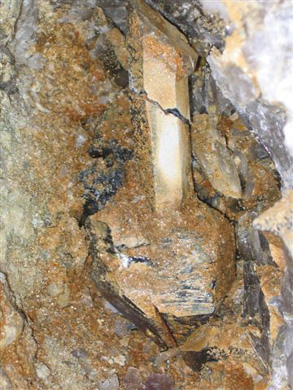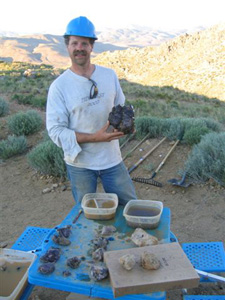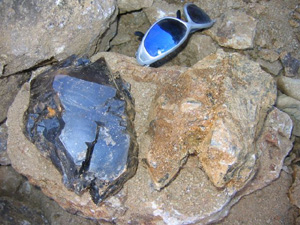Chapter 4
And mining became our routine. Day in and day out, we worked the mountain in hopes of liberating treasure. Some days we did well and were quite successful, others were less than satisfying, but nearly every day was filled with some type of crystal collecting good time. In order for us to maintain this level of activity, we had to keep the backhoe fueled and lubed and as much as any other thing, this duty welcomed us to each new morning. We usually added between ten and twenty-five gallons of fuel, depending on the amount of work we'd performed the previous day, and followed this with a walk through cleaning out grease zerks prior to greasing the machines many lubrication points. This took about an hour most mornings and was a duty we always strived to have completed prior to Jon's arrival. Another activity we performed on the backhoe was replacing the bucket teeth as they became overly worn or broken. We ate these up and went through 3 complete sets of teeth during our operation. Acting as support angels, Ed and Jim ran most of the fuel on and off the mountain and were really terrific sports, always sharing smiles and laughter while they visited.
But the meat and potatoes of our activities, they happened in the pit. There our operation advanced into the rock from several different fronts and while seemingly chaotic, we proceeded with a distinct goal, a focused attack which advanced us quickly into potentially productive ground while facilitating waste rock removal. This work centered around several different areas that were named during the course of our adventure, these areas became known as The Portal, The Monolith and Amyland.
The Portal was an access area we cut through from an adjacent claim to work a lower level of Jon's claim. We put many days work into this area and made some of our finest discoveries here. In fact, the biggest pocket found, a discovery made by Scott while raking at walls newly exposed by Jon and the machine, came from this area. That and dozens of other pockets, including my best scepter pocket, they all came from The Portal.
The Monolith dominates the landscape of the claim. It is a beautiful monstrous, rounded fine grained granitic mass that rises dozens of feet above the surrounding area imperiously. This resistant rock lies in contact with another coarser grained granitic rock, much of which has been worked away, both by mining activities and by the long years where natural weathering stripped this less resistant rock away.
And finally, some of our first and later our best finds came from an area we called Amyland. Amethyst was extremely prevalent in this area and many exceptional specimens were recovered, some weighing up to several pounds. These large crystals could be quite exquisite, containing expansive gemmy areas and when found, they really set the heart to racing!
At this point, maybe this is a good time to discuss the crystals and where they form. This is a basic brew rich in quartz primarily, quartz that has formed during what appears to be several episodes of deposition. Most common are prismatic, gemmy smoky crystals. These crystals are commonly intimately
associated with mica which partially coats their prism surfaces leaving many pitted and scarred. Mica can form as dense pocket filling accumulations and there were times when both Scott and I were in pockets where our hands and forearms would be completely covered in its shiny, slick silvery coating. Finally, mica is a bane to the quartz from this deposit as with it present, a great deal of effort must be expended to remove it properly without damaging the quartz beneath. Smoky quartz crystals of this type formed within the classic geologic structures known as miarolitic cavities, while other smoky

quartz crystals formed within nearby milky quartz veins. Several episodes of quartz crystallization occurred within both host environments producing the incredible scepters this locality is so known for in color variations ranging from milky to colorlessly clear, from smoky to amethyst and finally, to citrine. As a last event, quartz reentered the system and where ideal conditions existed, large complex formations known popularly as "turkey heads" or "elestials", often encapsulating previously formed crystals, occurred. In rare examples, and Jon found a killer, these earlier crystals may "pop" free of this later forming parent mass revealing perfect impressions where they'd become emplaced. Smoky and amethyst color combinations prevail in these monster crystals. We all found specimens of this type, Jon and Scott found examples weighing up to five pounds, but the big dog of all, I found that one, it weighed ten pounds and is the second largest crystal of this type to have ever come off the claim. It is a glorious thing and is a specimen I was not only thrilled to collect, but additionally am thrilled to have been able to bring home! Towards the end of the dig, I did find one other that would have been larger, Jon guesstimated it in the twelve to fifteen pound range, unfortunately it was shattered into nearly a million tiny pieces that tinkled sadly as they cascaded from the open pocket. Incredibly, scepters forming during this last quartz enriching event have been recovered in lengths up to sixteen inches and weighing twenty four pounds! And finally, crystals formed during these last two events often contain, sometimes abundantly, two phase liquid and gas inclusions.


Next, Scott observed a goethite pseudomorph after pyrite while separating crystals back at camp as an inclusion within one smoky quartz, also noticed by Scott, and most awesomely in an incredibly big bright purple colored three by three inch crystal he'd found in Amyland, was a perfect negative crystal cast over an inch deep and wide seeming to represent a perfect feldspar crystal! We both found this an impressive quartz and while we found half a dozen other examples of quartz with these negative casts, this was the absolute finest and a unique find. It wasn't just cool mineralogically, it was beautiful too!
There wasn't much else beyond this that we observed, oh some pockets had varying sediments and there were a few pockets whose contents were coated in a sooty black substance (manganese, iron oxide?) and there was that one fracture in the granite showing copper mineralization, but that's about it, at least for what we found.
This brings us from the crystals, back to the places where they'd formed and this story of the miarolitic cavities and the quartz veins, it can be summed up in one word; pain! If these crystals could talk, theirs would be a tale of torment, the evidence was all around us, in every instance the quartz was shattered, crushed, broken, sheered, and the crystals had gone through H E double tooth picks! I can't tell you of any other locality I've ever worked where the crystals have suffered so much, it was heartbreaking. So many incredible specimens, big monsters and long delicate stemmed scepters and nearly everyone broken. Innumerable scepters were found whose shafts had been broken where the head meets it, some could be repaired, most could not. This abuse with the scepters reached its zenith with examples split top to bottom right down the crystals "C" axis. Split and splintered, the force it takes to do something like that, awesome! And so, find a pocket, see a shattered quartz vein, what do you do? You sift and rake through the shards and you keep a sharp, sharp eye out for that perfect face when it appears and then you slow way down, being careful not to nick or ding your new treasure, and you work it free slowly from the rubble and you hope and hope and hope that there's a head at the end of that long beautiful smoky quartz.
Report continued . . . . . . .
Click Here for Next Page